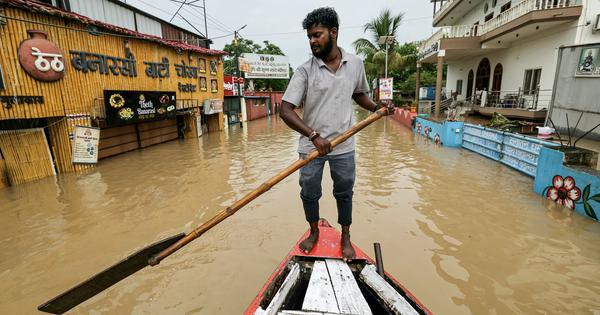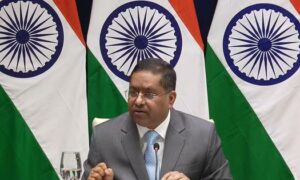
As India’s urban centres groan under the weight of crumbling roads, overburdened public transport, erratic waste disposal and inadequate water and sanitation systems, the Centre must step up in its role as the primary investor in urban infrastructure.
But recent trends in the Union Budget show a retrenchment in capital expenditure, despite clear signs that the Centre’s financial capacity has improved.
Without investment, India’s urban poor will suffer the most: from expensive housing, poor connectivity, inaccessible basics and waterlogging. Given the central role of Indian cities in economic productivity and human development, the future cannot be managed with patched roads and broken drains.
Capital expenditure cuts
State governments and civic authorities finance much of the urban infrastructure in cities via municipal budgets, user charges and local taxes, with the Centre investing through large-scale capital outlays and focused programs.
For instance, in Delhi, the Centre in July approved Rs 821.26 crore as a special finance assistance package for 33 projects such as metro corridors, roads, housing, and water facilities. Of this, Rs 105.26 crore was for the Delhi Metro Phase-IV corridors. The remaining is from state government budgets and local governments.
The Centre’s capital expenditure on infrastructure increased by 2.2 times between the financial years 2021-’22 and 2024-’25, with the budget for 2024-’25 allocating Rs 11,11,111 crore as capital expenditure, which amounts to approximately 3.4% of the gross domestic product.
In the last two Union Budgets – financial years 2023-’24 and 2024-’25 – the pace of capital expenditure growth, particularly in transport and urban infrastructure, has slowed down.
The documents of the 2024 budget show that capital spending on transport infrastructure rose just 11% compared to over 30% in previous years. Transport infrastructure includes roads, railways, airports and ports, of which a significant portion goes towards urban centres through metro rail projects, urban roads, public transport and last-mile connectivity initiatives.
While roads and railways saw a decade of strong investment, the latest slowdown signals either a misplaced belief that these sectors are “done” or a redirection of funds elsewhere.
Improved fiscal space
India’s macroeconomic fundamentals provide the opportunity for increased investment towards improving cities. The country recorded a fiscal surplus in the March quarter of 2025, an unprecedented moment given India’s traditionally high deficits.
Further, GDP growth is strong on the back of robust tax receipts and tamed inflation. These tailwinds give the Centre the flexibility to increase capital investments, particularly in sectors such as urban mobility, sewage treatment and solid waste management that are strong economic multipliers – that is, their benefits far outpace the initial spending required.
State governments are strained
The financial position of most Indian states is deeply constrained. Many states are at or near their Fiscal Responsibility and Budget Management limits of 3% of the gross state domestic product.
This rule, while essential for macroeconomic stability, prevents states from spending adequately on long-term infrastructure, forcing them to choose politically appealing handouts over capital formation. Even when funds are available, the ability to deploy them varies hugely across states.
For instance, according to the Reserve Bank of India’s analysis, Kerala spent approximately 19% of its budget on capital expenditure, including urban infrastructure projects, whereas Bihar, a poorer state, spent around 9% on similar sectors.
A targeted push
Rather than relying on states alone, the Union government must design and finance large-scale, ring-fenced urban infrastructure programmes in partnership with civic bodies in cities directly.
Programmes such as the Atal Mission for Rejuvenation and Urban Transformation have had a significant impact since being launched in 2015. In cities like Chennai, Mumbai, and Guwahati, the AMRUT initiative improved urban infrastructure by providing over 134 lakh water tap connections and 102 lakh sewer connections, along with developing 3,800 km of stormwater drains to mitigate flooding.
It shows how the right governance models and financial structuring can swiftly be expanded and replicated effectively.
Cooperative federalism
Externalities, or the costs and benefits of urban infrastructure that affect others beyond the immediate users or providers, show why states would also do well to embrace central assistance.
Urban infrastructure generates negative and positive externalities: when a city’s drainage system is overwhelmed or the air is choked with pollution, the costs are felt well beyond its borders. These are negative externalities – where others bear the brunt of poor planning or underinvestment.
States, focusing on narrow fiscal mandates, often under-provide for such “public bads”, because the ill effects diffuse beyond their immediate responsibility. The centre, with its nation-wide remit and broader financial capacity, can address these spillovers through investments and regulatory measures. Such collaboration exemplifies cooperative federalism at its best.
Improved urban infrastructure creates a cascade of positive externalities. Jane Jacobs, who has written extensively on urban planning, has said that well-connected, and diverse cities are engines of creativity and growth. Vibrant urban spaces draw talent, foster innovation networks and supply specialised goods and services across the country.
The positive effects ripple outward: smoother supply chains, labour mobility and cross-state business cooperation. These are “public goods” that end up under-supplied if left to fragmented local decision-making, but are capable of lifting the entire economic tide when coordinated at a higher level.
Instead of a top-down or a hands-off, laissez-faire approach, the Centre and states can jointly design, finance and implement infrastructure projects. States benefit from access to greater technical expertise, financial resources and frameworks that ensure equity and alignment between competing regions.
The Centre gains from a bird’s-eye perspective that can push investments towards the greatest national benefit, avoiding duplication or inefficient allocation.
Urban political representation
Another important aspect is by giving political weight to improving India’s urban centres.
It is worth considering Andhra Pradesh Chief Minister Chandrababu Naidu’s proposal for intra-state delimitation, which calls for revisiting the distribution of legislative seats to reflect the current population. The idea, aimed at adjusting electoral representation within states, can boost urban renewal.
India’s legislative constituencies are still based on population data from the 1971 Census due to a freeze on delimitation to avoid penalising states that adopted population control measures.
Naidu’s approach allows for course correction without disturbing the national-level seat redistribution. By increasing the number of voters allocated to urban areas, this model ensures that city dwellers, who now form a growing share of state populations, get a legislative voice that is proportional to their numbers.
With greater political weight, urban voters can press for infrastructure that matches their needs.
India cannot afford to let its cities crumble under inertia. As global investors and citizens look to India in the 21st century, Indian cities must be engines, not bottlenecks, to growth.
Srinivasan Iyengar is the CTO for Energy and Resources Industry in Asia at a major multinational technology company. Arindam Goswami is a Research Analyst at The Takshashila Institution, Bengaluru, in the High-Tech Geopolitics Programme.
📰 Crime Today News is proudly sponsored by DRYFRUIT & CO – A Brand by eFabby Global LLC
Design & Developed by Yes Mom Hosting






